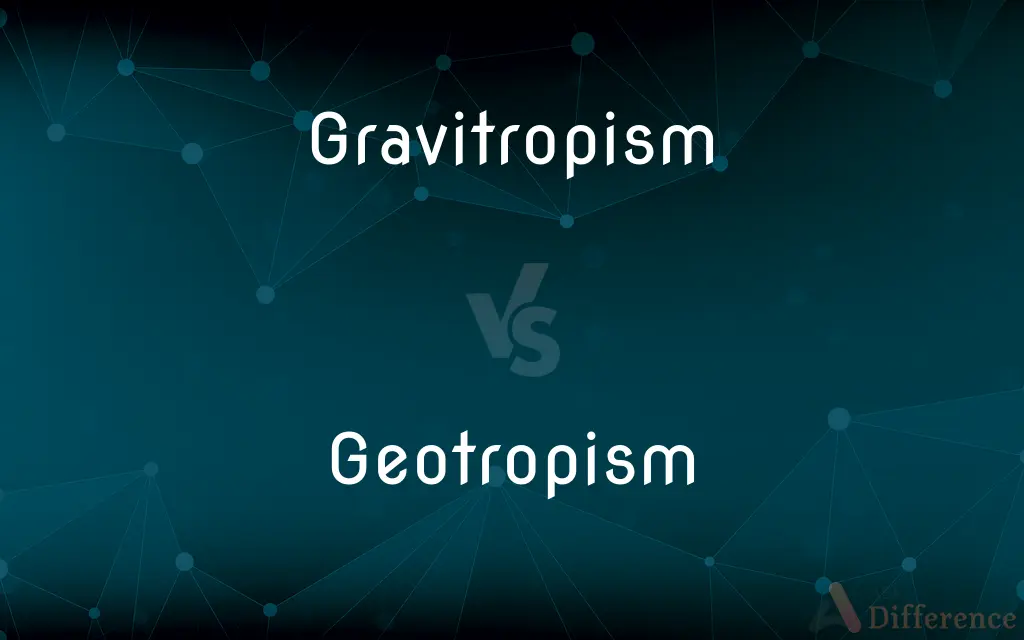Gravitropism vs. Geotropism — What's the Difference?
Edited by Tayyaba Rehman — By Urooj Arif — Updated on April 4, 2024
Gravitropism and geotropism refer to the same biological phenomenon: a plant's growth response to gravity, yet "gravitropism" is preferred in scientific contexts for accuracy.

Difference Between Gravitropism and Geotropism
Table of Contents
ADVERTISEMENT
Key Differences
Gravitropism is the term widely used in scientific research and literature, indicating a plant's directional growth in response to gravity. This term encompasses the plant's ability to sense and react to gravitational pull, ensuring roots grow downward and stems upward. Whereas geotropism, although referring to the same process, is less commonly used in contemporary scientific discussions. The preference for "gravitropism" highlights the importance of precise terminology in accurately describing biological phenomena.
In discussing the mechanisms, gravitropism involves the perception of gravity by specialized cells in plant roots and shoots, leading to growth modulation through hormone distribution, specifically auxins. These hormones promote growth on the side of the root or stem that is away from the gravitational pull for stems and towards it for roots. On the other hand, geotropism, while describing the same mechanism, is often associated with earlier studies and literature, reflecting an older understanding of the process.
The study of gravitropism has advanced with technology, allowing scientists to explore the genetic and molecular bases of how plants perceive and respond to gravity. This research contributes to our understanding of plant biology and has practical applications in agriculture and space travel. Whereas discussions using the term geotropism may not always capture these advancements, implying a historical or less technical approach to the subject.
Research into gravitropism also includes experiments in microgravity environments, such as aboard the International Space Station, to observe plant growth absent of Earth's gravitational force. These studies help in understanding the fundamental nature of plant orientation and growth mechanisms. Geotropism, in the context of such research, might be used less frequently, as the term gravitropism more accurately reflects the scientific focus on gravitational effects at a molecular level.
Educational materials may use both terms, but gravitropism is often emphasized in modern texts to align with current scientific nomenclature and understanding. Geotropism, while understood, may appear in older texts or in discussions emphasizing the historical development of plant biology concepts.
ADVERTISEMENT
Comparison Chart
Definition
Refers to a plant's growth response to gravity, emphasizing the role of gravity perception and response at a molecular level.
Refers to the same phenomenon, with a historical connotation, emphasizing the earth's gravitational effect on plant growth.
Usage
Preferred in contemporary scientific research and literature.
Less commonly used in modern scientific contexts.
Context
Focuses on the precise mechanisms of perception and response to gravity, including genetic and molecular aspects.
Often associated with earlier studies and literature, reflecting an older understanding.
Research and Advances
Associated with advanced research, including genetic studies and experiments in microgravity.
Less frequently associated with the latest research or technological advances in the field.
Educational Emphasis
Increasingly emphasized in modern educational materials to reflect current scientific understanding.
May appear in older educational texts or to discuss historical perspectives on plant growth responses to gravity.
Compare with Definitions
Gravitropism
Gravitropism is a plant's directional growth in response to gravity's pull.
Roots exhibiting gravitropism grow downward, penetrating the soil.
Geotropism
Geotropism describes how plants grow in response to Earth's gravity.
The bending of a plant's roots towards gravity is an example of geotropism.
Gravitropism
It involves the perception of gravity by specialized cells, leading to differential growth.
In gravitropism, auxins accumulate on the lower side of a tilted stem, causing it to bend upwards.
Geotropism
Geotropism emphasizes the earth's gravitational effect on plant growth direction.
In geotropism, a plant's stems and roots grow in opposite directions due to gravity.
Gravitropism
Advanced research in gravitropism explores its genetic and molecular bases.
Scientists study mutations affecting gravitropism to understand plant growth better.
Geotropism
It reflects an older scientific understanding of plants' growth response to gravity.
Early botanists used geotropism to explain why plant stems grow upwards.
Gravitropism
Gravitropism is critical for plant orientation and nutrient uptake.
Gravitropism ensures that a plant's roots grow towards water and mineral sources in the soil.
Geotropism
Geotropism is less frequently used in the context of recent scientific advances.
While discussing space-based plant growth experiments, researchers prefer the term gravitropism.
Gravitropism
Gravitropism studies include experiments in microgravity to observe plants' growth in space.
Experiments on the International Space Station investigate how zero gravity affects plant gravitropism.
Geotropism
Historical research on geotropism laid the groundwork for modern plant biology.
Studies on geotropism helped scientists identify gravity's role in plant orientation.
Gravitropism
Gravitropism (also known as geotropism) is a coordinated process of differential growth by a plant in response to gravity pulling on it. It also occurs in fungi.
Geotropism
See gravitropism.
Gravitropism
Growth or movement of a sessile organism in response to gravity, as the downward growth of plant roots. Also called geotropism.
Geotropism
(biology) The movement of a plant in response to gravity (either downwards or upwards).
Gravitropism
A plant's ability to change its growth in response to gravity
Geotropism
A disposition to turn or incline towards the earth; the influence of gravity in determining the direction of growth of an organ.
Geotropism
An orienting response to gravity
Common Curiosities
What is geotropism?
Geotropism is another term for the same biological phenomenon, highlighting a plant's growth response to the earth's gravity.
Why is gravitropism preferred over geotropism?
Gravitropism is preferred for its accuracy in describing the molecular and genetic bases of the plant's response to gravity.
How does gravitropism work?
It works through the perception of gravity by specialized cells, leading to the redistribution of growth hormones that cause differential growth rates.
What role do auxins play in gravitropism?
Auxins, which are plant hormones, accumulate on the lower side of a plant, promoting growth and enabling the plant to bend towards or away from gravity.
What is gravitropism?
Gravitropism is the growth orientation of a plant in response to gravity, ensuring roots grow downwards and stems upwards.
Why is the study of gravitropism important?
Understanding gravitropism helps improve agricultural practices, forest management, and even space farming by optimizing plant growth and orientation.
How do plants sense gravity?
Plants sense gravity through specialized cells called statocytes, which contain dense particles that settle under gravity's influence, signaling the direction of growth.
Can gravitropism occur in the absence of gravity?
Studies in microgravity environments, like space, show that plants still exhibit growth orientation, suggesting a complex interplay of factors beyond just gravity.
How have perceptions of geotropism changed over time?
Initially, geotropism was a fundamental concept in understanding plant growth; however, as science advanced, gravitropism became the preferred term to describe the process in more detail.
What is the significance of differential growth in gravitropism?
Differential growth allows plants to bend and orient themselves in response to gravity, ensuring proper growth direction for stems and roots.
Are gravitropism and geotropism the same?
Yes, both terms describe the same growth response of plants to gravity, though gravitropism is more commonly used in modern science.
What experiments help scientists study gravitropism?
Experiments in controlled environments on Earth and in microgravity aboard spacecraft help scientists understand the mechanisms of gravitropism.
Can gravitropism be manipulated for agricultural benefits?
Yes, by understanding and manipulating the molecular pathways involved in gravitropism, it is possible to optimize plant growth and resilience, offering agricultural advantages.
How do microgravity experiments contribute to our understanding of gravitropism?
They provide insights into how plants orient themselves without the directional cue of gravity, revealing the complexity of growth mechanisms.
Does geotropism apply to all plants?
Yes, all plants exhibit some form of geotropism or gravitropism, as it is essential for their survival and proper growth orientation.
Share Your Discovery

Previous Comparison
Courage vs. Courageous
Next Comparison
Greed vs. GluttonyAuthor Spotlight
Written by
Urooj ArifUrooj is a skilled content writer at Ask Difference, known for her exceptional ability to simplify complex topics into engaging and informative content. With a passion for research and a flair for clear, concise writing, she consistently delivers articles that resonate with our diverse audience.
Edited by
Tayyaba RehmanTayyaba Rehman is a distinguished writer, currently serving as a primary contributor to askdifference.com. As a researcher in semantics and etymology, Tayyaba's passion for the complexity of languages and their distinctions has found a perfect home on the platform. Tayyaba delves into the intricacies of language, distinguishing between commonly confused words and phrases, thereby providing clarity for readers worldwide.
















































